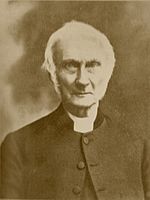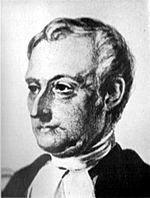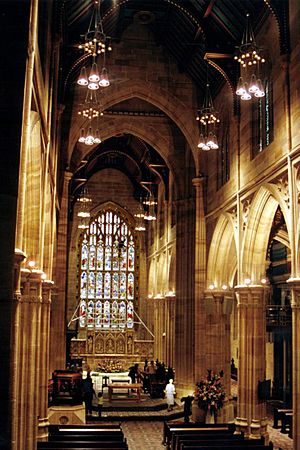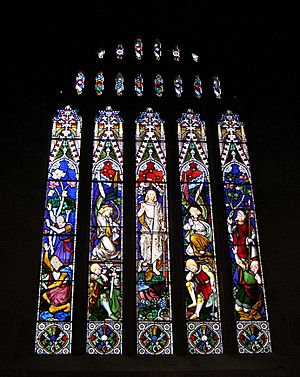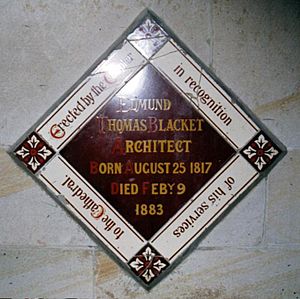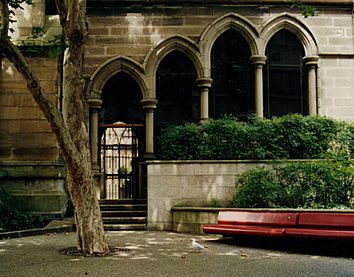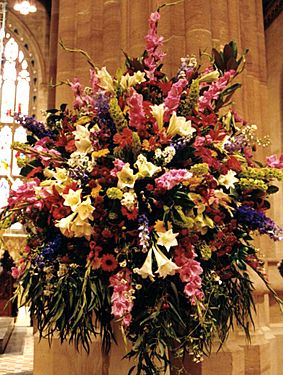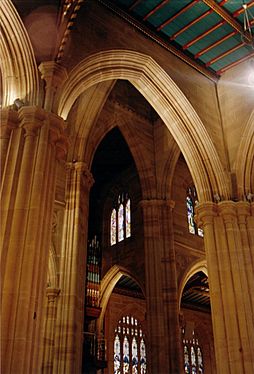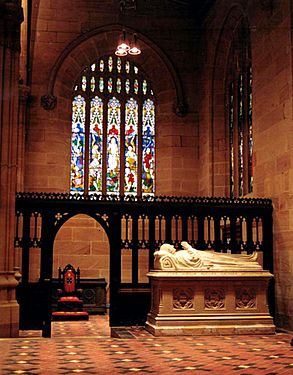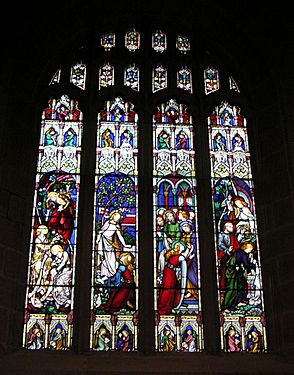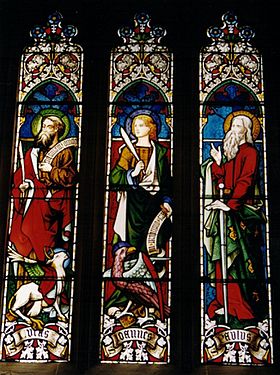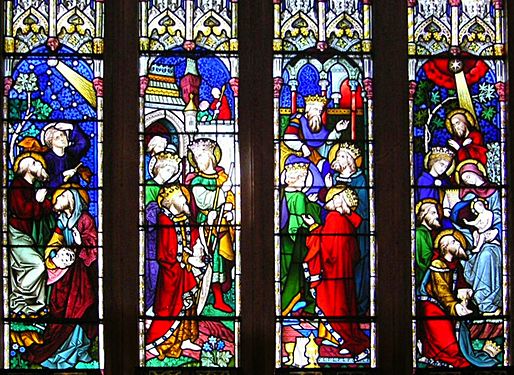St Andrew's Cathedral, Sydney facts for kids
{{Infobox church | name = St Andrew's Cathedral, Sydney | fullname = Cathedral Church of Andrew the Apostle | image = Sydney NSW 2000, Australia - panoramio (291) adj.jpg | imagesize = 300px | imagealt = | landscape = | caption = West front | pushpin map = Australia Sydney central | pushpin label position = | pushpin map alt = | pushpin mapsize = 270 | map caption = Location in the Sydney central business district | coordinates = 33°52′26″S 151°12′23″E / 33.873923°S 151.206336°E | osgraw = | osgridref = | location = George Street, Sydney CBD, New South Wales | country = Australia | denomination = Anglican | tradition = | churchmanship = Low church evangelical | membership = | website = sydneycathedral.com | former name = | bull date = | consecrated date = | people = | status = | functional status = | heritage designation = | designated date = | previous churches = | architect = Edmund Blacket | architectural type = Cathedral | style = Gothic Revival | years built = | groundbreaking = 1837 | completed date = 1868 | construction cost = | closed date = | demolished date = | capacity = | length = 48 metres (157 ft) | length nave = | length choir = | width = 17.6 metres (58 ft) | width nave = | width transepts = 33.3 metres (109 ft) | height = 29.7 metres (97 ft) | height nave = | height choir = | dome quantity = | dome height outer = | dome height inner = | dome dia outer = | dome dia inner = | tower quantity = | tower height = 40 metres (130 ft) | spire quantity = | spire height = | archdiocese = | metropolis = | diocese = Sydney | diocese start = | province = New South Wales | archbishop = Kanishka Raffel | dean = Sandy Grant | precentor = | archdeacons = | reader = | director = Ross Cobb | organist = | logo = | logosize = | logolink = | logoalt =
| embedded = } St Andrew's Cathedralis a famous cathedralchurch in Sydney, Australia. It belongs to the Anglican Church of Australia. This cathedral is the main church for the Anglican Archbishop of Sydney, who is currently Kanishka Raffel. The Dean of Sydney is Sandy Grant. St Andrew's Cathedral is known for its "Evangelical" Christian teachings. It holds church services every day, including a special healing service each week. The cathedral has a choir of men and boys who sing during school terms. There is also a group of people who ring the church bells. The large pipe organ has been fixed up and is often used for concerts. The cathedral was mostly designed by Edmund Blacket. Building started in 1837 and finished in 1868. It was ready for services and officially opened in 1868. This makes it the oldest cathedral in Australia. St Andrew's is a great example of Gothic Revival architecturein Sydney. This style tries to copy the look of old European churches. It is located on George Streetin the center of Sydney. The cathedral is listed on the New South Wales State Heritage Register, which means it's an important historical building.
Contents
- Early Plans and Challenges
- Edmund Blacket's Vision
- Inside the Cathedral
- Cathedral Layout and Changes
| Official name | St Andrew's Anglican Cathedral and Chapter House |
|---|---|
| Type | State heritage (complex / group) |
| Criteria | a., b., c., d., e., f., g. |
| Designated | 3 September 2004 |
| Reference no. | 1708 |
| Type | Cathedral |
| Category | Religion |
|
Invalid designation
|
|
| Official name | St Andrew's Cathedral Group Including Interiors, Courtyard Spaces and Forecourts |
| Type | Local government heritage (complex / group) |
| Criteria | a., c., d., f. |
| Designated | 14 December 2012 |
| Reference no. | I1793 |
| Type | Built |
| Category | Cathedral |
Discovering the Cathedral's Design
Early Plans and Challenges
Back in 1819, Lachlan Macquarie, an early Governor of New South Wales, had big plans for Sydney. He wanted a very large cathedral. He worked with an architect named Francis Greenway. They laid the first stone, but the plan was too expensive for the young colony. So, it was stopped.
Later, in 1837, Bishop William Grant Broughton started again. New plans were made by architect James Hume. These plans were for a smaller church in the Gothic style. Only a small part of Hume's design was built, but the foundations and some walls were put in place.
Edmund Blacket's Vision
In 1842, a talented architect named Edmund Thomas Blacket arrived. He was known for designing buildings in both Classical and Gothic styles. Blacket became very famous in Sydney, designing many important buildings.
Blacket took over the cathedral project from Hume. He had to work with the foundations that were already there. He designed the cathedral in a style called Perpendicular Gothic. This style uses many repeated shapes and strong vertical lines. It makes the building look grand and balanced, even though it's not huge. The front of the cathedral, with its towers and decorations, is very impressive.
Bishop Broughton passed away in 1853 and never saw the cathedral finished. The second Bishop of Sydney, Frederick Barker, officially opened the completed building on November 30, 1868.
Inside the Cathedral
The inside of St Andrew's Cathedral is also in the Perpendicular Gothic style. Even though the building is not enormous, it feels grand. This is because of its tall arches, rich decorations, and the high, painted hammerbeam roof. The building is made from local Sydney sandstone.
The floor in the front part of the church (the chancel) has beautiful patterns made with marble and tiles. The rest of the floor uses red and black tiles. The wooden seats for the choir are made of dark English oak and have detailed carvings.
The large carved screen behind the main table, called the reredos, was made in 1886. It shows scenes from the Bible. Originally, it showed the Crucifixion, Resurrection, and Ascension. However, some people thought the Crucifixion image was too much like idolatry, so it was replaced with the Transfiguration.
The lower stained glass windows are very old and beautiful. They were made by Hardman of Birmingham and show stories from the life of Jesus. The large window at the east end of the church shows scenes where Apostle Andrew was present. The west window shows tiers of Apostles.
Cathedral Layout and Changes
St Andrew's Cathedral is built in a cruciform (cross) shape, which is common for churches. The main part of the church is called the nave. It is crossed by the transept, and at the eastern end is the chancel where the clergy and choir sit.
Most cathedrals face east-west, with the main door at the west. St Andrew's was built this way. But the busy George Street runs along the east side. This made the main entrance less useful. Also, when trams were installed on the street, their noise often made it hard to hear services.
So, in 1941, the inside of the cathedral was changed. The main table was moved to the west end, and the west door was closed. This helped with the noise from the trams. However, it also affected the sound inside the church.
From 1999 to 2000, major work was done to put the cathedral back to its original layout. The main table was moved back to the eastern end. During this work, a large stained glass window showing the Crucifixion was uncovered.
The cathedral also has a very old book called the Great Bible from 1539. It was given to St Andrew's as a thank you from a church in England. This Bible is displayed to show how important the Bible is to the Sydney Anglican church.
Music at St Andrew's
The Organ
In 1866, a large organ made by William Hill & Sons was installed. It had beautiful decorated pipes. Later, in 1932, another organ was added. In the 1950s, these two organs were joined together. This made it the largest church organ in Australia.
The organ was updated again in 1998. Today, it is still a very important part of the cathedral's music. You can often hear Australian and international organists play free concerts on Thursday afternoons.
Organists and Choir Masters
- Montague Younger 1868–1899
- Joseph Massey 1900–1923
- F. Mewton 1923–1926
- Thomas Haigh 1927
- Thomas Beckett 1928–1947
- Edgar Bainton (acting) 1948
- Hugh Bancroft 1948–1953
- Kenneth Long 1953–1957
- Mervyn John Byers 1957–1965
- Michael Hemans 1966–1980
- Michael Deasey 1981–2005
- Ross Cobb 2005–
The Cathedral Choir
The Cathedral Choir of men and boys is the oldest continuous musical group in Australia, starting in the 1820s. Many famous people have been part of the choir, including Australia's first prime minister, Sir Edmund Barton, and the pilot Sir Charles Kingsford Smith.
In 1885, St Andrew's Cathedral School was started to train boys to sing in the choir. The school has grown a lot since then. In 1999, girls were also allowed to join the older years, and now it is a school for both boys and girls from kindergarten onwards.
The choir often travels to perform. In 2008, they went to Europe to celebrate the choir's 140th anniversary. They sang in famous places like Bristol Cathedral and St Paul's Cathedral in London. They also sang in Venice and Florence.
The choir sings at the Sunday morning service and at evening services on Mondays and Thursdays.
The Bells
St Andrew's has a set of 12 bells. They were made in England and installed in 1965. These bells are rung by members of The Australian and New Zealand Association of Bellringers every Sunday morning and during practice nights.
Cathedral Materials

- Building - Sydney sandstone
- Roof - Welsh slate
- Lower windows, east and west windows, transept windows, - Hardman of Birmingham, 1861-8
- Nave clerestory windows - designer, Norman Carter, 1953-4
- Chancel and transept clerestory windows - various, including Lyon and Cottier, Falconer and Ashwin and English firms.
- Floor - Minton intaglio tiles
- Chancel floor - Cosmateque tiles by Fields of London
- Pulpit and Choir stalls - English Oak
- Reredos - English Alabaster
- Pulpit- Otago sandstone and Gabo Island granite
Town Hall Group
St Andrew's Cathedral is part of a group of important historical buildings in Sydney called the Town Hall Group. This group also includes the Sydney Town Hall, the Queen Victoria Building, the old Gresham Hotel, and the old Bank of New South Wales building. All these buildings are listed as heritage sites.
Deans of St Andrew's
- From Sydney Cathedral website
Picture gallery
Images for kids
See also
 In Spanish: Catedral de San Andrés (Sídney) para niños
In Spanish: Catedral de San Andrés (Sídney) para niños


